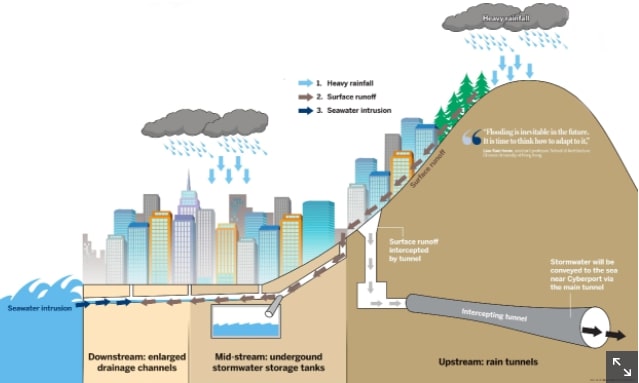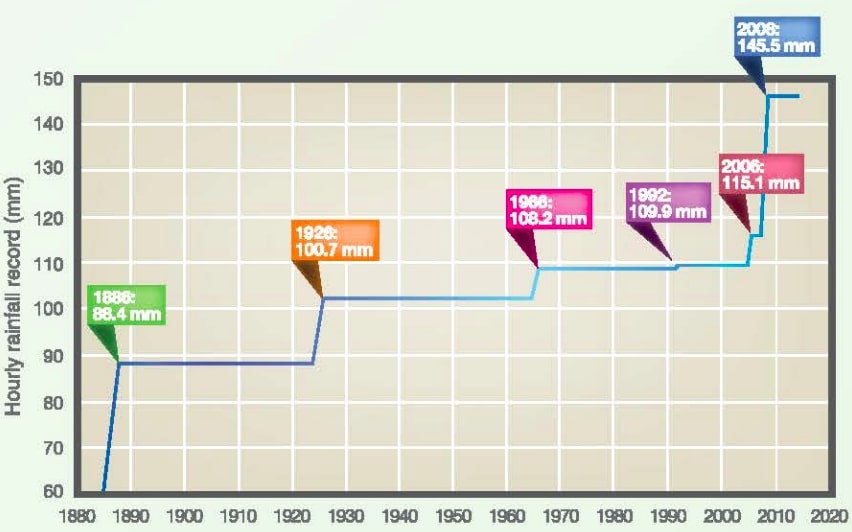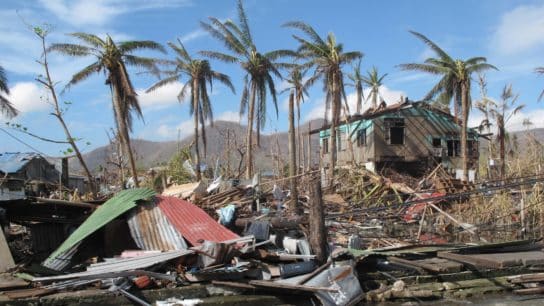Hong Kong’s topography is not one that lends itself well to rampant urbanisation and a high population density. The territory’s mountainous geography, its tropical climate and a lack of flat land have presented persistent challenges to urban developers in Hong Kong. In addition to the city’s seaward expansion through land reclamation projects, it has also migrated skyward, tracing the slopes of coastal mountains and hills. Through complex slope stability and rainwater drainage systems, residential buildings and urban dwellers have settled upon the territory’s steep hillsides. In the coming years, landslides may present a heightened risk to the city’s hillside communities, given the tropical climate, gradual slope degradation and population growth in Hong Kong.
—
Slopes in Hong Kong can broadly be described as either natural or man-made. Man-made slopes include any hillside land or rock formation that has been cut, fitted with a retaining wall or used for other human activity. Around 60% of Hong Kong’s land consists of natural and undeveloped terrain, which has not been substantially modified by human activities. Due to rampant urbanisation since the mid-20th century, Hong Kong’s development boundary- the line where urban areas meet natural terrain- is primarily located at points where hills become too steep to develop.
Hong Kong’s tropical climate drives cyclical periods of dry and wet seasons, with the latter being accompanied by tropical storms and abundant rainfall. During periods of heavy rainfall, Hong Kong’s mountainous landscapes experience a high risk of landslides. Rainfall tends to be the most common cause of landslides, which can occur when precipitation rates exceed 70 mm per hour, although this is also dependent on other factors including soil integrity. Short bursts of intense rain can cause rapid erosion and soil destabilisation, leading to slope failure. The risk of landslides in tropical climates increases with development and urbanisation, which tends to disrupt soil stability.
95% of Hong Kong’s population live on 20% of its land, with most of this developed area being located at or in close proximity to the development boundary. Hills with an incline steeper than 30° tend to be liable to landslides; around 30% of hillsides in Hong Kong are steeper than this.
Past landslides in Hong Kong have been well documented. Over a few days in August 1971, Typhoon Rose struck Hong Kong, bringing strong winds and heavy rainfall. The city recorded an August record of 288.1 mm of rain in a single day, causing the territory’s soil to oversaturate and become severely waterlogged. The following June, a series of landslides devastated neighbourhoods in Central and Wan Chai, causing the deaths of 138 people.
You might also like: What Are the Main Threats to China’s Food Security?

Image 1: The site where a 12-storey residential building toppled following the 1972 landslide; South China Morning Post; 2017.
Since 1947, 470 people have been killed by landslides in Hong Kong. Recognising the fatal risks of slope failure and landslides, the Hong Kong government has implemented a variety of slope maintenance and rainwater drainage measures that protect the city’s residents and infrastructure from landslides.
Broadly, the main trigger for landslides is heavy rainfall, and the magnitude and impact of a slope failure event is compounded by population density and human activity. However, a warming climate and intensifying extreme weather events will present a clear challenge over the coming years. Increasingly severe tropical storms will bring heavier rainfall which, when combined with soil erosion, population growth and continued urban development, will magnify the existing risk to hillside settlements in Hong Kong.
Slope Failures and Mitigation Strategies
Slope failures- when the integrity of hillside soil and rock becomes extensively damaged- are a common and natural occurrence in Hong Kong. A mountainous landscape combined with a tropical climate highly increases the probability of slope failure. Urban development and population growth have only added to the natural risk factor.
The concentration and intensity of rainfall over short periods exacerbate oversaturation and soil erosion. Annually, around 80% of rainfall occurs during the wet season, between May and September. The intensity of rainfall during a tropical storm is such that it is not uncommon for over 10% of annual rainfall to occur over the span of a few hours. During severe storms, precipitation can exceed 400 mm over a 24-hour period. Average precipitation in Hong Kong in a year is 2400 mm.
The high concentration of precipitation during short bursts of intense rainfall causes a high degree of surface runoff, which occurs when soil is oversaturated and precipitation exceeds the rate at which water can be absorbed. Surface runoff is compounded by urbanisation, as paved surfaces and other man-made structures impede water absorption. Excessive surface runoff can cause spillage from natural water basins such as valleys and depressions, and resultant flooding increases the rate of soil erosion. Under heavy rainfall, spillage and flooding tends to occur either during or immediately after a storm, making landslides and slope failures difficult to predict and plan for.
To minimise the risk of slope failures and landslides, Hong Kong has invested heavily in developing its urban rainwater drainage system. Since 1995, the city has invested $3.8 billion into projects that include 2 400 km of drains, 360 km of river channels, four underground tunnels that cumulatively span 21 km and four massive stormwater storage tanks, with 11 more tanks slated for construction. The intricate rainwater drainage system in Hong Kong minimises the erosion impact of heavy rainfall on hillside soil by redirecting and storing stormwater in vast containment tanks.

Image 2: Visualisation of Hong Kong’s stormwater drainage system; China Dialogue; 2017.
Following the 1972 landslides, the Hong Kong government acknowledged the risks of urban development on steep slopes. The government created a Landslide Potential Index (LPI) to estimate the potential of a rainstorm to trigger landslides. In 1977, the government’s Geotechnical Engineering Office (GEO) established the Landslip Warning System, which takes into account the correlation between rainfall, landslides and human activity to create predictions on slope failure and potential landslide risks across the city.
The system has been progressively upgraded and modernised over the years to improve its efficiency, incorporating Internet of Things (IoT) and cloud computing technology to improve real-time rainfall data collection and transmission. IoT technology embeds infrastructure with smart communications software and wireless environmental sensors that can perform real-time risk analysis. With this system, the GEO can identify circumstances with a high potential for slope failure, and instantly coordinate impact mitigation efforts, including maintenance, public alerts and evacuations.
Urban Development and Growing Potential for Slope Failure
Rapid urban development that encroaches upon natural habitats is a standard policy measure in Hong Kong, whether through slope maintenance on land or land reclamation practices in the sea. Hong Kong’s population is projected to increase over the coming decades, hitting a peak of 8.1 million in 2041. The city will inevitably look to urbanise further to satisfy residential and commercial infrastructure demand.
Without extensive mitigation efforts, urbanisation coupled with a rugged terrain predisposed to landslides can be a catastrophic combination. In 2017, three days of torrential rainfall triggered a series of devastating mudslides in Freetown, the capital of Sierra Leone. The mudslide caused the deaths of at least 1 141 people. While rainfall acted as a trigger for the mudslide, poorly-executed urban planning had degraded hillside soil, placing thousands at risk.
In 2014, over 1 600 landslides occurred over an area of 385 km² in Liguria, Italy, causing three deaths and widespread structural damage. The landslides were found to have primarily occurred due to rainfall and were compounded by human activity in the area, including excessive terracing for agricultural purposes, overbuilding of infrastructure, stream modifications and paved road extensions.
These cases should serve as a cautionary tale for urban developers in Hong Kong. While the city has implemented a series of expansive and innovative measures to mitigate the effects of heavy rainfall, it will also concurrently continue to urbanise and grow its population. Cases such as those in Sierra Leone and Italy indicate that, while heavy rainfall tends to be a trigger for landslides, rampant urbanisation and human activity in areas with a predisposition for slope failure places populations in vulnerable and perilous positions.
Impacts of a Changing Climate
Hong Kong’s circumstances are certainly different from those mentioned above. The city possesses immense financial capacity, as well as access to modern technological and infrastructural resources. The city is able to focus its efforts and resources on effective urban planning and floodwater mitigation strategies. Should environmental circumstances remain unchanged, these strategies may prove resilient enough for the city to continue developing on natural slopes.
However, Hong Kong’s floodwater and slope failure mitigation strategies will face a significant challenge in the coming years in the face of climate change and intensifying tropical storms.
The Intergovernmental Panel on Climate Change (IPCC) states that climate change will lead to a decrease in the overall frequency of tropical storms, however the frequency and intensity of particularly powerful storms will increase. Tropical storms are formed by differences and exchanges in temperature and air pressure above water bodies. Warm water is the primary energy source of a tropical storm, as higher water temperatures feed more heat and energy to power the storm.
Ocean temperatures have been rising over the past 25 years, and will fuel increasingly frequent and intense Category 4 and 5 tropical storms. Consensus projections regarding cyclones specifically indicate that the overall number of storms will decrease by 5 to 30%, although the frequency of Category 4 and 5 storms in particular will increase by up to 25%
More intense tropical storms will be accompanied by stronger winds and heavier rainfall, likely to increase between 5 and 20% over a storm’s lifetime within 100 km of their centres. Additionally, sea level rise will increase the likelihood of damage caused by storm surges. Overall, the risk of excessive flooding and surface runoff from inundations and heavier precipitation will increase substantially over the coming decades.
In Hong Kong, the correlation between climate change and the increasing intensity of rainfall during the wet season is already apparent. The Hong Kong Observatory noted this year that, while it used to take several decades for rainfall to break hourly precipitation records, these records have been broken several times over the past 20 years. A 2015 study using radiocarbon dating in landslide sites over the past 28,000 years on Lantau Island concluded that periods of significant landslide activity in the past coincided with known changes in climate, and expressed concerns over the increased risk of natural terrain landslides and man-made slope failures due to global warming.

Figure 3: Hourly precipitation rate record markers at the Hong Kong Observatory; Hong Kong Observatory; 2020.
Intense extreme weather events have been occurring regionally at a more frequent rate. In 2009, Typhoon Morakot made landfall in Taiwan over two days in August, producing the highest recorded precipitation the region had experienced in 50 years. As a result of the typhoon, Xiaolin Village in southern Taiwan was devastated by a combination of landslides and river floods, causing the deaths of 465 people. Should similar rainfall occur near the heavily developed and populated slopes of Hong Kong, the impact would be catastrophic.
Steps for Risk Mitigation
Hong Kong will need to accomplish several tasks to be prepared for the consequences of more frequent and intense rainfall during its wet season. Specifically, the city will need to strengthen its existing drainage infrastructure, enhance institutional capacity for community preparedness and response systems and minimise the degrading impact of human activity on natural systems.
The first two challenges are somewhat linked, in that emergency preparedness systems can be integrated with strengthened drainage and slope maintenance systems. The Landslip Warning System is a good example of the benefits of an IoT approach to surveillance and monitoring. IoT technology allows officials to coordinate separate but fundamental components of an effective risk analysis. It could, for instance, instantly reconcile precipitation rate data collected by the Hong Kong Observatory during a tropical storm, soil quality and slope integrity data collected by the GEO and local drainage capacity data from the Department of Drainage Services. A more expansive IoT approach can incorporate immediate emergency response in terms of issuing community evacuation notices and mobilising rescue operations.
As important as engineering and innovative technology will be, raising public awareness of the dangers of slope failure will be crucial, especially in more at-risk areas. The government could focus on developing an educational public communications campaign, involving publicity events in neighbourhoods more prone to landslide damage and producing informational public messaging on social media and television. Officials can also organise public committees on slopes which involve residents and private landowners to more actively engage the public. Costs could be minimised by focusing campaigning efforts during the weeks and months leading up to the wet season.
To mitigate the impact of urban development in aggravating landslide risks, city planners will need to reconcile demands for more liveable space with minimising environmental impact. A strategy that the city could pursue is green roofing, a practice that Hong Kong has already somewhat embraced. A green roof consists of three layers, a top layer covered in vegetation, a substrate dividing layer and a bottom drainage layer. The soil and vegetation on green roofs can help absorb, drain and eventually transpire rainwater where it would otherwise become surface runoff.
Green roofs can be effective in alleviating the strain placed on urban drainage systems during heavy rainfall, as they can free up more space in drainage tunnels and storage tanks. Green roofs can also delay spillage events when man-made and natural drainage systems become oversaturated, by lowering the overall amount of surface runoff water. In addition to stormwater absorption, green roofs increase biodiversity and provide urban cooling and ventilation. Green surfaces can also be applied to building walls, highway infrastructures and slope retaining walls. Green roofs present some drawbacks, in that they need to be scaled up significantly to have a measurable impact. Green roofing as a policy measure has also been criticised for deterring cities from investing in more effective green spaces on the ground.
While Hong Kong’s engineering systems may assuage concerns about slope failure damage, the risk of landslides is real, and will become progressively more threatening as the climate continues to warm. Tropical storms and heavy rainfall will never be completely avoidable, although the city can mitigate their consequences, without necessarily having to sacrifice development targets. A focus on preparedness and public awareness through embedded communication systems can maximise response efficiency. Sustainable urbanisation strategies can incorporate drainage systems into development plans and minimise surface runoff. To avoid calamitous economic and infrastructural damages, and to prevent fatalities, Hong Kong will need to take certain steps to be prepared for any eventuality.
Featured image by: Wikimedia Commons














